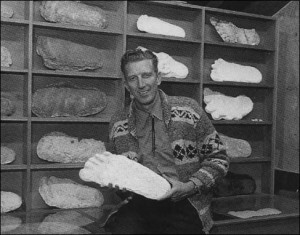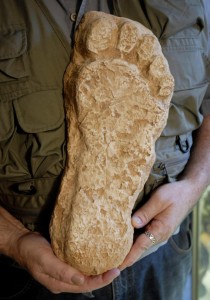Do Sasquatch Feet Show Celtic Toes?
Posted by: Loren Coleman on November 10th, 2010

Neandertals left their tracks, above, behind. Have they left more with us? In our toes?
Yes, it is called the Celtic toe, Morton’s toe, or the Roman toe. The medical profession tends to think something is wrong with having a Celtic toe, and it is labeled a Morton’s toe. Some people have them cut off, as if there is some kind of pathology involved with having such a large digit. Archaeology has discussed the finds of such toes for years.

Ten percent of all Americans have them (due to their Irish-Scottish background, reportedly), but some nationalities, like Greeks, have these toes show up 90% of the time. Lady Liberty of the famed Ellis Island’s Statue of Liberty has Celtic toes.

Some highly speculative notions have been published that the Celtic toe is Neandertal in nature. But do the tracks of Neandertals even show Celtic toes?

Neandertal track.
Most Bigfooters don’t think that the Celtic toe ever shows up in Bigfoot/Sasquatch tracks? Is that true? Not really.




Are all toes of Bigfoot really only gradually shorter than their large toes? Variety is the key here. In the tracks of Sasquatch, for example in the Grays Harbor series of 1982, it does seem there is evidence of apparent Celtic toes. In the Patterson-Gimlin Filmsite tracks, Celtic toes are not visible.

Visitors to the International Cryptozoology Museum sometimes share their Celtic and other intriguing toes with the staff.

How many of you have a Celtic toe?

A photograph (directly below) of a 1.5 million-year-old footprint found among others at a Northern Kenya site showing good definition of the toe pads; the second toe is partially obscured by the third toe (but is longer than the big toe). The researchers identified the footprints as probably belonging to a member of Homo ergaster, an early form of Homo erectus. Credit: Matthew Bennett/Bournemouth University, Feb 2009.

About Loren Coleman
Loren Coleman is one of the world’s leading cryptozoologists, some say “the” leading living cryptozoologist. Certainly, he is acknowledged as the current living American researcher and writer who has most popularized cryptozoology in the late 20th and early 21st centuries.
Starting his fieldwork and investigations in 1960, after traveling and trekking extensively in pursuit of cryptozoological mysteries, Coleman began writing to share his experiences in 1969. An honorary member of Ivan T. Sanderson’s Society for the Investigation of the Unexplained in the 1970s, Coleman has been bestowed with similar honorary memberships of the North Idaho College Cryptozoology Club in 1983, and in subsequent years, that of the British Columbia Scientific Cryptozoology Club, CryptoSafari International, and other international organizations. He was also a Life Member and Benefactor of the International Society of Cryptozoology (now-defunct).
Loren Coleman’s daily blog, as a member of the Cryptomundo Team, served as an ongoing avenue of communication for the ever-growing body of cryptozoo news from 2005 through 2013. He returned as an infrequent contributor beginning Halloween week of 2015.
Coleman is the founder in 2003, and current director of the International Cryptozoology Museum in Portland, Maine.










Italian/Cajun/Brit-something husband and Irish/English/Scottish/Indian (feather, not dot)/heaven knows wife and our children all have this “Celtic toe.”
Hmmm, interesting that there is a name for my oddity. I always thought it was normal that the second toe was bigger than the big toe, but then why would they call it the big toe. Very interesting.
While not longer then the big toe, my second toe is nearly the same length, as is all my toes except the pinky/little toe.
Mine is longer. I also noticed a paucity of scientific data when I googled this. There were a lot of blog pages and the like, but I didnt’ look up “Morton’s” either. I’ll have to check that out. As for Neanderthal, hasn’t their DNA been pretty well excluded from our own through numerous independent tests? Yet we keep hearing hints that we have Neanderthal DNA in our own.
So instead of the “big” toe, maybe it should be called the “wide” toe?
I never knew it had a formal name to the 2nd toe being longer then the first toe. I have a scottish hertigae so it falls in line with the article. As for it being a neanderthal trait, I think it is possible. Although it is more possible that this is a regional adaptaion passed on through the generations.
Hmmm, my wife just calls my toes “finger toes”, now I can correct her.
Living my entire life in or around Eugene, Oregon, I have webbed toes!
GO DUCKS!!!
But seriously, my three middle toes on each foot are slightly webbed. It has never slowed me down, quite the contrary; I swim real fast. LOL
Yes, I have them, and they are even more pronounced than those in your photo. And I have had to have surgery on them, although it didn’t help. These kinds of toes are a big problem when women are forced to wear fashionable, pointy-toed shoes like the ones that were fashionable in the early 1960s and which have been brought back recently. They are a contributing factor in the formation of bunions, and they also tend to get callouses on the top of them, by rubbing against the tops of shoes. Since most dressy women’s shoes don’t have much depth, this toe rubs constantly.
Interestingly, although I have mixed ancestry from all the British Isles on one side of my family, on the other side we are descended from short, stocky very dark haired Germans from southern Germany. Some of the adult men in my grandfather’s family were not taller than 5 foot and very broad. I also have very large bones and very big feet and hands [although my brow ridges are quite smooth.] Neanderthal in the family tree?
A recent article discussed a scientific study that pointed to the theory that Neandertals were more obsessed with sex than us wimpy Homo Sapiens.
This discovery came from analyzing the length of the “ring finger” in Neandertal remains.
So now I’m wondering if the “Celtic toe” can also be a sign of a higher level of testosterone, and thus confirming a Neandertal ancestry in those who have them.
Just giving you one more chance to brag about, my Irish amigos 😛
I too have this “Celtic” toe but never heard that term before. I always just thought it was a normal foot/toe variation which it seems to be. My second toe is a lot longer than the wider but shorter “Big” toe and even my next toe is about equal in lenght to the Big toe. So what does that mean?
I was also born with 6 Celtic toes – 3 one each foot!
Since as a woman I couldn’t find shoes to fit, I had to have surgery when I was 21. They simply removed the middle knuckle and since then no problems.
I’m a 23yr old male with small toes. My second toe is a little bigger than my big toe, it’s a little bigger. Meaning that is’ almost the same size as my first toe. My middle toe is about the same size as my first toe. My feet are size 7 in guy shoes. But I wear 7 1/2 🙂
eireman:
I’m an Archaeology Student specialising in Prehistory, the Homo Neanderthal Genome Project confirmed that Eurasian Humans contain 5% Neanderthal DNA. for cultural reasons were not supposed to talk about, were not aloud to say that technically anyone who isn’t African (descent) is a sub-species, some people not afraid to talk about think Eurasians should be called Homo Sapien Neanderthalensis. Personally with the change in Y chromosomes in charts across the world i wouldn’t be surprised if we found Home Erectus DNA in some people in the Far Eastern descent as Erectus went extinct there more recently. Then there is Homo Florensis and the shorter islanders there?
So yeah went off on one but Eurasians are part Neanderthal, so yeah the toe thing could come from them but we are not at the point yet where we can identify which features we have inheritted from them, but we will find out eventually (We’ve just been learining Human genetic origin).
The “Ten percent of all Americans have them (due to their Irish-Scottish background, reportedly)” is probably not correct; also don’t forget us English and Welsh in US ancestory!
Also on that note if me talking about ethinicity had offended anyone, i apologise as it was not my intent, it’s just part of me thinks it’s wrong treat part of Human science as a taboo even though i understand why.
Everyone on my Father’s side of the family has a “Celtic Toe” only we call it the Jacobs’ Toe.
Me and my sisters all have this Celtic toe. I didn’t know what it was called until reading this.
I have to admit I never really thought about it before.
We’re in the UK and have Irish ancestry so we’ve been told.